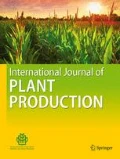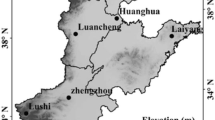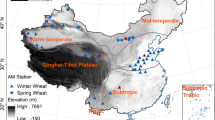Abstract
Understanding how crop phenology responds to historical climate change is a prerequisite for evaluating crop phenology and future yield responses. Most phenology response investigations are based on the phenology observed under circumstances of varieties changing over time, which then necessitates disentangling the role of climate change from the effect of changing varieties using various models. However, results from such studies are limited by the uncertainties caused by model mechanisms and assumptions and parameter calibration and validation. In this study, phenology observations were made for varieties of winter wheat (Triticum aestivum L.), rice (Oryza sativa L.), and spring maize (Zea mays L.) at 11 agro-meteorological observation sites in north China. The varieties observed for each species did not change over a period of at least 15 years. The observations were used to investigate the measured phenology response to climate. Dates of major wheat phenology stages tended to occur earlier due to warming, but the trend in rice and spring maize was not clear. Growth duration was shortened during the vegetative period of winter wheat, but was prolonged during vegetative period of rice and in the reproductive period of winter wheat and rice. Growing degree days (GDD) were generally increased for both vegetative and reproductive periods for all crops except during the vegetative period for winter wheat. We found that most trends in date of phenology stages, duration of growth phases, and GDD were similar to previous reports in which the varieties observed did not remain constant. This indicates that previous reports are likely to have overestimated the effect of cultivar shifting on crop phenology and underestimated the role of climate. Based on our results, growth duration under future warmer conditions may be longer than previously simulated, and hence yield may also be higher than previously estimated.





Similar content being viewed by others
Change history
28 January 2019
The original version of this article unfortunately contained mistakes. Table 1 was incorrect. The corrected table is given below.
References
Anwar, M. R., Liu, D. L., Farquharson, R. J., Macadam, I., Abadi, A., Finlayson, J., et al. (2015). Climate change impacts on phenology and yields of five broadacre crops at four climatologically distinct locations in Australia. Agricultural Systems, 132, 133–144.
Bonhomme, R., Derieux, M., & Edmeades, G. O. (1994). Flowering of diverse maize cultivars in relation to temperature and photoperiod in multi-location field trials. Crop Science, 34(1), 156–164.
Chinese Meteorological Administration. (1993). Agricultural Meteorological Observation Specification (Vol. 1, pp. 4–18). Beijing: China Meteorological Press. (in Chinese).
Chmielewski, F. M., Müller, A., & Bruns, E. (2004). Climate changes and trends in phenology of fruit trees and field crops in Germany, 1961–2000. Agricultural and Forest Meteorology, 121, 69–78.
Estrella, N., Sparks, T. H., & Menzel, A. (2007). Trends and temperature response in the phenology of crops in Germany. Global Change Biology, 13(8), 1737–1747.
García-Mozo, H., Mestre, A., & Galán, C. (2010). Phenological trends in southern Spain: A response to climate change. Agricultural and Forest Meteorology, 150, 575–580.
He, L., Asseng, S., Zhao, G., Wu, D. R., Yang, X. Y., Zhuang, W., et al. (2015). Impacts of recent climate warming, cultivar changes, and crop management on winter wheat phenology across the Loess Plateau of China. Agricultural and Forest Meteorology, 200, 135–143.
Hu, Q., Weiss, A., Feng, S., & Baenziger, P. S. (2005). Earlier winter wheat heading dates and warmer spring in the US Great Plains. Agricultural and Forest Meteorology, 135, 284–290.
Kumudini, S., Andrade, F. H., Boote, K. J., Brown, G. A., Dzotsi, K. A., Edmeades, G. O., et al. (2014). Predicting maize phenology: intercomparison of functions for developmental response to temperature. Agronomy Journal, 106(6), 2087–2097.
Li, K. N., Yang, X. G., Tian, H., Pan, S. F., Liu, Z. J., & Lu, S. (2015). Effects of changing climate and cultivar on the phenology and yield of winter wheat in the North China Plain. International Journal of Biometeorology, 60(1), 21–32.
Liu, J., Yao, N., Lin, H. X., Zhou, Y. G., Wu, S. F., Feng, H., et al. (2016). Response mechanism and simulation of winter wheat phonology to soil water stress. Transactions of the Chinese Society of Agricultural Engineering, 32, 115–124. (in Chinese).
Liu, L. L., Wang, E. L., Zhu, Y., & Tang, L. (2012). Contrasting effects of warming and autonomous breeding on single-rice productivity in China. Agriculture, Ecosystems & Environment, 149, 20–29.
Liu, Z. J., Hubbard, K. G., Lin, X. M., & Yang, X. G. (2013). Negative effects of climate warming on maize yield are reversed by the changing of sowing date and cultivar selection in Northeast China. Global Change Biology, 19(11), 3481–3492.
Major, D. J., Brown, D. M., Bootsma, A., Dupuis, G., Fairey, N. A., Grant, E. A., et al. (1983). An evaluation of the corn heat unit system for the short-season growing regions across Canada. Canadian Journal of Plant Science, 63(1), 121–130.
McMaster, G. S., & Wilhelm, W. W. (2003). Phenological responses of wheat and barley to water and temperature: Improving simulation models. Journal of Agricultural Science, 141, 129–147.
Meng, L., Liu, X. J., Wu, D. R., & Wang, C. Y. (2015). Response of summer maize main phenology to climate change in the North China Plain. Chinese Journal of Agrometerology, 36(4), 375–382. (in Chinese).
Menzel, A., Estrella, N., & Testka, A. (2005). Temperature response rates in long-term phenological records. Climate Research, 30(1), 21–28.
Porter, J. R., & Gawith, M. (1999). Temperatures and the growth and development of wheat: A review. European Journal of Agronomy, 10(1), 23–36.
Sadras, V. O., & Moran, M. A. (2013). Nonlinear effects of elevated temperature on grapevine phenology. Agricultural and Forest Meteorology, 173, 107–115.
Siebert, S., & Ewert, F. (2012). Spatio-temporal patterns of phenological development in Germany in relation to temperature and day length. Agricultural and Forest Meteorology, 152, 44–57.
Tao, F. L., Zhang, S., & Zhang, Z. (2012). Spatiotemporal changes of wheat phenology in China under the effects of temperature, day length and cultivar thermal characteristics. European Journal of Agronomy, 43, 201–212.
Tao, F. L., Zhang, S., Zhang, Z., & Rötter, R. (2014). Maize growing duration was prolonged across China in the past three decades under the combined effects of temperature, agronomic management, and cultivar shift. Global Change Biology, 20, 3686–3699.
Tao, F. L., Zhang, Z., Shi, W. J., Liu, Y. J., Xiao, D. P., Zhang, S., et al. (2013). Single rice growth period was prolonged by cultivars shifts, but yield was damaged by climate change during 1981–2009 in China, and late rice was just opposite. Global Change Biology, 19, 3200–3209.
Torrion, J., Setiyono, T. D., Cassman, K., & Specht, J. (2011). Soybean phenology simulation in the north-central United States. Agronomy Journal, 103(6), 1661–1667.
van Oort, P. A. J., Zhang, T. Y., de Vries, M. E., Heinemannd, A. B., & Meinkea, H. (2011). Correlation between temperature and phenology prediction error in rice (Oryza sativa L.). Agricultural and Forest Meteorology, 151, 1545–1555.
Wang, E. L., & Engel, T. (1998). Simulation of phenological development of wheat crops. Agricultural Systems, 58(1), 1–24.
Wang, J., Wang, E. L., Feng, L. P., Yin, H., & Yu, W. D. (2013). Phenological trends of winter wheat in response to varietal and temperature changes in the North China Plain. Field Crops Research., 144, 135–144.
Wang, L., Wu, Z. F., He, H. S., Wang, F. X., Du, H. B., & Zong, S. W. (2017). Changes in start, end, and length of frost-free season across Northeast China. International Journal of Climatology, 37(1), 271–283.
Wang, N., Wang, J., Wang, E. L., Yu, Q., Shi, Y., & He, D. (2015). Increased uncertainty in simulated maize phenology with more frequent supra-optimal temperature under climate warming. European Journal of Agronomy, 71(71), 19–33.
Wang, Z. B., Chen, J., Tong, W. J., Xu, C. C., & Chen, F. (2018). Impacts of climate change and varietal replacement on winter wheat phenology in the north China Plain. International Journal of Plant Production.. https://doi.org/10.1007/s42106-018-0024-0.
Wu, D. R., Wang, C. Y., Wang, F., Jiang, C. Y., Huo, Z. G., & Wang, P. J. (2018). Uncertainty in simulating the impact of cultivar improvement on winter wheat phenology in the North China Plain. Journal of Meteorological Research, 32(4), 636–647.
Xiao, D. P., Tao, F. L., Liu, Y. J., Shi, W. J., Wang, M., Liu, F. S., et al. (2013). Observed changes in winter wheat phenology in the North China Plain for 1981–2009. International Journal of Biometeorology, 57, 275–285.
Xiao, D. P., Tao, F. L., Shen, Y. J., Liu, J. F., & Wang, R. D. (2014). Sensitivity of response of winter wheat to climate change in the North China Plain in the last three decades. Chinese Journal of Eco-Agriculture, 22(4), 430–438. (in Chinese).
Zhang, S., Tao, F. L., & Zhang, Z. (2014). Rice reproductive growth duration increased despite of negative impacts of climate warming across China during 1981–2009. European Journal of Agronomy, 54, 70–83.
Zhang, T. Y., Huang, Y., & Yang, X. G. (2013). Climate warming over the past three decades has shortened rice growth duration in China and cultivar shifts have further accelerated the process for late rice. Global Change Biology, 19, 563–570.
Zhang, T. Y., Zhu, J., & Yang, X. G. (2008). Non-stationary thermal time accumulation reduces the predictability of climate change effects on agriculture. Agricultural and Forest Meteorology, 148(10), 1412–1418.
Acknowledgements
This research was jointly supported by the Basic Research Funds-regular at the Chinese Academy of Meteorological Sciences (2017Z004) and National Natural Science Foundation of China (31771672).
Author information
Authors and Affiliations
Corresponding author
Rights and permissions
About this article
Cite this article
Wu, D., Wang, P., Jiang, C. et al. Measured Phenology Response of Unchanged Crop Varieties to Long-Term Historical Climate Change. Int. J. Plant Prod. 13, 47–58 (2019). https://doi.org/10.1007/s42106-018-0033-z
Received:
Accepted:
Published:
Issue Date:
DOI: https://doi.org/10.1007/s42106-018-0033-z




